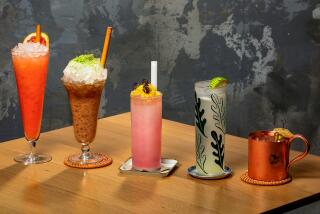It’s Dry and Chilled and Sipped All Over
It is liquid diamond, a minimalist see-through presence. Urbane, 100 proof glamour in a glass. The silver bullet. Sin with an olive.
It is, of course, the martini.
And if you haven’t ordered one lately--if only as an artful accessory--you may already be out of style.
According to a worshipful new biography, the swellegant elegant “tooni” is divinely and blessedly back. Back in the mahogany-paneled hotel bars, back in the white-on-white yuppie living rooms, back even among Generation Xers on the “90210” set.
And Barnaby Conrad III, a self-described fifth-generation Yalie and martini drinker, has caught the crystalline wave with his chic new cocktail-table book, “The Martini” (Chronicle).
The glossy volume toasts the drink’s renaissance by pulling together hundreds of photographs, drawings, essays and cartoons about Conrad’s favorite potion. “So much more than just a cocktail,” swoons the author, 43. “It is the American symbol of elusive perfection, a kind of pagan Holy Grail.”
Then again, the Martini Revival may reflect nothing more than a growing national appetite for olives.
Or maybe it’s just nostalgia. In a world before Breathalyzer and codependence, the martini was the icon for the American Dream. “If you were drinking martinis, you had either arrived or you were well on your way,” as Conrad puts it.
Although Conrad did not taste his first martini until 1988, as a child he spent many a happy cocktail hour in his father’s swanky nightclub sipping ginger ale and listening for the “magic in the gravel-like hiss of the martini shaker.”
The dangerous muse for generations of writers, actors and politicians, the martini is well represented in American literature and history.
It was the first drink mixed in the White House after President Franklin D. Roosevelt signed the law ending Prohibition. W.C. Fields used to drink two doubles for breakfast. And in his “The Thin Man” detective series, Dashiell Hammett gave the martini a starring role with the forever tipsy Nick and Nora Charles.
“What hit me?” asks Nora after six martinis.
“The last martini,” Nick replies.
Dorothy Parker, a regular at the Algonquin Hotel’s martini-laden Roundtable, issued a famous warning about the high-octane drink.
“I like to have a martini/Two at the very most/After three I’m under the table/After four I’m under my host.”
Ian Fleming’s James (“shaken, not stirred”) Bond was the human embodiment of the martini, according to Conrad. A classy composition of opposites: brute strength (the gin) and sensitivity (the aromatic vermouth).
Despite its grandiose history, the details of the martini’s beginnings remain a mystery even in Conrad’s extravagantly researched book. Suffice to say it was probably invented by a bartender in Martinez, Calif., sometime in the 1860s and served as a three-to-one combination of gin and vermouth with a dash of orange bitters.
Then, as now, it was a drink served chilled--”teeth-chatteringly cold,” Conrad says. The gin should “smoke” when poured over the ice into the (preferably silver) shaker.
And to assure the martini is properly sipped, never swilled, it should be delivered in a long-stemmed cone-shaped glass. “That way,” Conrad notes, “the martini cannot be belted back in one toss--or at least not without losing much of it on your shirt front.”
*
Over the last century, the original formula has been adulterated by all manner of variations: rinsing the glass in Cointreau, substituting vodka for gin and adding olives, lemon, onions, cherries, pygmy eggplants or even crystallized violets in an effort to achieve The Perfect Martini.
Some years ago, a Chicago restaurant built a contraption called the Martini-Matic to offer data on how dry (that is to say, strong) customers liked their drinks. Factory workers chose a gin-to-vermouth ratio of 3 to 1, advertising execs 5 to 1 and publishers 7 to 1.
Why we drink martinis at all has been the subject of other, more academic study, most notably by Rutgers University classics professor Lowell Edmunds.
In a scholarly treatise on martinis, Edmunds argues that, at least for the adult, upper-class, optimistic male, the martini is a nostalgic passport to a time when fathers and other “pillars of the community” gathered to drink the cold, clear cocktail.
“To such a man,” Edmunds concludes, “the martini is a form of communion with his ancestors. The martini is the living past.”
As for the obvious hazards of martini-drinking, Conrad does not hide from them.
He recounts in excruciating detail the case of Daniel Malamud as reported in the October 1985 edition of the New England Journal of Medicine.
“While eating the onion in his martini, the Philadelphia biochemist swallowed the wooden toothpick. Panicked, he ran to the bathroom and made himself vomit. This vaulted the toothpick into his nasal passage. Waiting in the emergency room, the poor man watched as the nurse wrote on the blackboard: “Malamud. Toothpick up nose.”
Malamud, it should be noted, was more fortunate than the famous American author Sherwood Anderson, who died of peritonitis after swallowing a toothpick from a martini olive. As for other perils, “The Martini” book cautions readers only not to drink too fast.
“You’ve got all night, maybe all your life, before things get so bad a martini can’t help,” says Conrad.
More to Read
Eat your way across L.A.
Get our weekly Tasting Notes newsletter for reviews, news and more.
You may occasionally receive promotional content from the Los Angeles Times.









